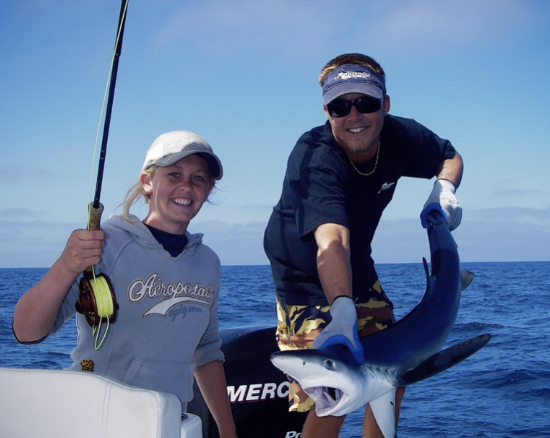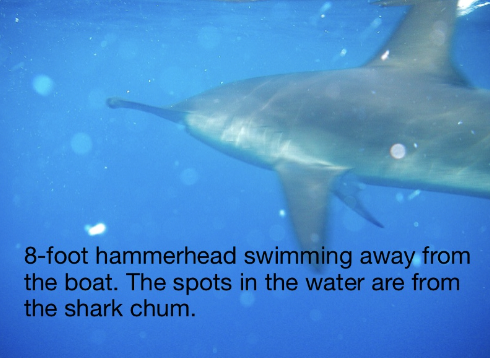by Ted Eisele
It started as I was watching a tv show featuring Conway Bowman (a one-time host of Flyfishing the World). Conway had been a pioneer in the sport of fishing for Pacific sharks with a fly rod. He was targeting mako sharks. Each time they’d hook one, the shark would go on drag-burning runs and make leaps that would make a steelhead jealous. My reaction to the show was immediate and strong. I’ve gotta try that!
I contacted Conway, who was fully booked. But he told me to talk to one of his protégés, Dave Trimble, who operated On The Fly outfitters in San Diego. Done! It was booked for September, and I would bring my daughter along to share in the adventure. Katie had not fly fished much, but she loves the outdoors and is an adventurous soul.

Trimble had a 14-weight Sage Xi rod as well as a 10-weight. He would start me out with the 14 weight, since the first fish we attracted to the chummed water was a big 8-foot hammerhead. Casting that rod felt like trying to cast with a telephone pole. There was no flex at all, and it was exhausting. I wondered if it was really necessary to go that big. Trimble tried to tease the fish with a spin rod lure that had no hook, and I was to then cast my fly as he pulled his lure away to entice a take. Over and over again we tried, but he would not play. Finally I said, “let’s forego the teaser and let’s just try the fly.” This generated more interest from the big fish, and he would cruise right up alongside the side of the boat, which is how the guide measured him. As he started acting more excited and aggressive, he went to the back of the boat and bit the motor mount. Yikes! I turned to my daughter and said, “we’re NEVER telling your mother!” (At least I didn’t say something cheesy like “we’re gonna need a bigger boat”, even though that’s about what I felt at that moment. ) The fish went back to cruising just under the side of the boat and then turned and started going straight back toward the stern, which would give me a perfect angle for a good hook set. Bang! He was on.
He ran like crazy, and I told Dave, “there’s no way I can keep up with this fish unless we start the motor and follow him.” That allowed me to stay up with him, but now that “telephone pole” of a fly rod had a huge bend in it. Yeah, the guide knew what he doing after all! I needed every bit of that rod’s strength. Then instead of running in the top of the water column, he went straight to the bottom. For the umpteenth time I thought that fish would spool me for sure. But I worked him back up, and finally got him on the surface looking like a tired, beached whale. I was sure we had him, but I was as tired as he was. Then he surprised us by flexing his tail fin all the way around to his mouth area until it severed the 30-pound leader. Dave had timed it and said I fought that fish for 45 minutes!

The next sharks to arrive were blue sharks. The ones that showed up were small, only 6 to 12 pounds. But they were so much fun I could have caught them all day. Sight fishing is always a thrill, and the casts are close enough to the boat that you watch every move the fish makes, always hoping it results in a take. My daughter had never caught a fish on a fly rod, and she took a turn, hooking a beautiful 12-pound blue shark. I was so excited I was trying to coach her to make sure she didn’t lose her first good fish. Of course our guide coached her too, and I’m sure I sounded like a typical nervous dad watching his kid play a Little League game. At any rate, despite having 2 people shouting advice to her, she landed the fish, and the smile she flashed may have been the biggest I’ve ever seen (see photo). What a way to record your first fish!
We ended up landing 5 blue sharks. I got to touch the head of one of the fish, and as you may have heard, while their skin looks very smooth, it feels like sandpaper.
By this time the long-anticipated mako showed up. It looked just like a great white, but smaller. In A.J. McClane’s Game Fish of North America, he says “The glorious mako is one of the world’s great game fish ... probably no other fish can achieve as much elevation.”
This wasn’t one of the giant 100-pound makos that are sometimes landed. Dave estimated it as a 50-pound fish. I got it all the way to the boat’s hull and it was at least 4-feet long. Still, what a thrill to not only get a mako, but to hook 3 different species of shark.
We caught the mako (and all the blue sharks) on the 10-weight rod, which was much more fun to cast. But it would have been too light for the hammerhead.
It was a day I’ll never forget. Not only for the fishing, but for having my daughter there to share in the day. And Dave Trimble was a great guide. He knew his stuff and was a great guy to spend the day with. If you want a special thrill, try a day with him off San Diego.

